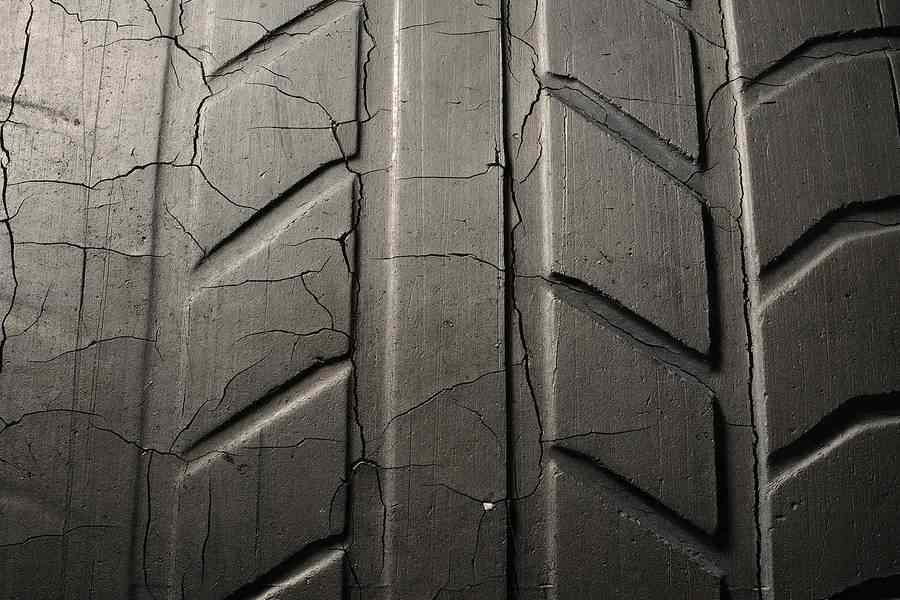Cracked Tires: When They're Unsafe
If you've ever driven on aging tires, you might have noticed small cracks that develop in the sidewall, and even between the treads, of your tires. While this cracking can be a common sign of aging in rubber tires, it is also a sign of potential trouble that drivers need to take seriously.
Weather cracked tires have become a more urgent warning sign due to advancements in rubber tire development. Where cracking was prevalent in older generations of rubber tires, advancements in tire production have led to the use of special additives that delay the onset of cracking and extend the lifespan of rubber tires. As a result, cracking in tires isn't the constant problem it used to be—but cracks do still develop, and they need to be taken seriously when they do.
What Causes Tire Sidewall Cracking?
Cracks are a sign that the rubber in your tires is starting to break down. This happens naturally due to exposure to UV light, oils, chemicals, and other elements that slowly break down compounds and reduce the rubber's flexibility over time.
As this flexibility declines, cracks develop. Once cracks develop, it's only a matter of time before the tire reaches the end of its lifespan and needs to be replaced. Even small cracks will continue to grow as the tire takes on more wear and tear—especially as the flexibility of the rubber deteriorates. If left unaddressed, cracks will eventually lead to a split tire where the sidewall of the tire breaks open, rendering the wheel unusable.
What Causes Tires to Crack in the Tread?
While tire sidewall cracks are more common and unavoidable, cracks in tire tread are a potentially urgent concern that drivers need to address. In most cases, a crack in the tire tread develops first on the sidewall, and then moves to the outer part of the tire, going underneath the tread. Tire tread cracks can also indicate dry rot underneath the tread that could lead to the tread blowing off the wheel entirely, which can put the vehicle at risk of losing control on the road.
Cracks in your tire treads need to be examined immediately. Given the thickness of this part of the tire, the crack likely indicates an underlying structural issue that could put the driver and other vehicles in danger.
When are Cracks in Tire Sidewall Unsafe?
When sidewall cracks are minor and superficial, it may be safe to continue driving on the tires. Sidewall cracks aren't completely out of the ordinary, and small cracks that are barely visible aren't likely to represent an imminent safety concern.
If sidewall cracks continue to grow in length, depth, or number, you may want to consider replacing your tires. This cracking can wear down the tire fast, and a small number of visible cracks can quickly lead to several major cracks that put your tire at serious risk of a sidewall blowout. In addition, cracks on a tire that is only a few years old may indicate a manufacturing defect in the tire, which needs to be addressed and likely replaced as soon as possible.
If tire cracking between treads is visible, it's important to have a trusted tire professional inspect the tire and, in most cases, replace the tire—even if the tread depth on your tires is still healthy. The visible cracking on the treaded part of the tire likely indicates compromises to the structural integrity of the tire that makes it unsafe to drive on the road.
How to Prevent Weather Checked Tires
The best way to prevent weather checked tires is to keep tires shielded from the elements as much as possible. Sunlight, water, and salt from winter roads can all accelerate the degradation of the tire rubber, which leads to cracking. To maximize the longevity of your tires, and prevent cracking, do the following:
- Store your vehicle in a garage whenever possible, away from direct sunlight.
- Don't allow tires to sit in standing water.
- Clean snow and mud off tires after you've finished driving.
- Keep tires properly inflated, to reduce the strain placed on the tire's rubber.
Don't let your vehicle sit stationary for too long. A stationary tire can develop cracks faster. Even if you don't need to use your vehicle, take it for a spin every few days to move the tires around and give the tire rubber a little "exercise."
Keep in mind that even with the best care, your vehicle's tires won't last forever. Most tire manufacturers give each tire an expiration date of six to 10 years after its production, due to the inevitable degradation of the tire's rubber.
If you're concerned about cracking on your tires, ignoring the issue could lead to a dangerous mishap while driving, including a blown tire that causes your vehicle to lose control. Err on the side of caution and have these cracks examined by a trusted tire professional—and, if necessary, outfit your vehicle with a set of replacements.


